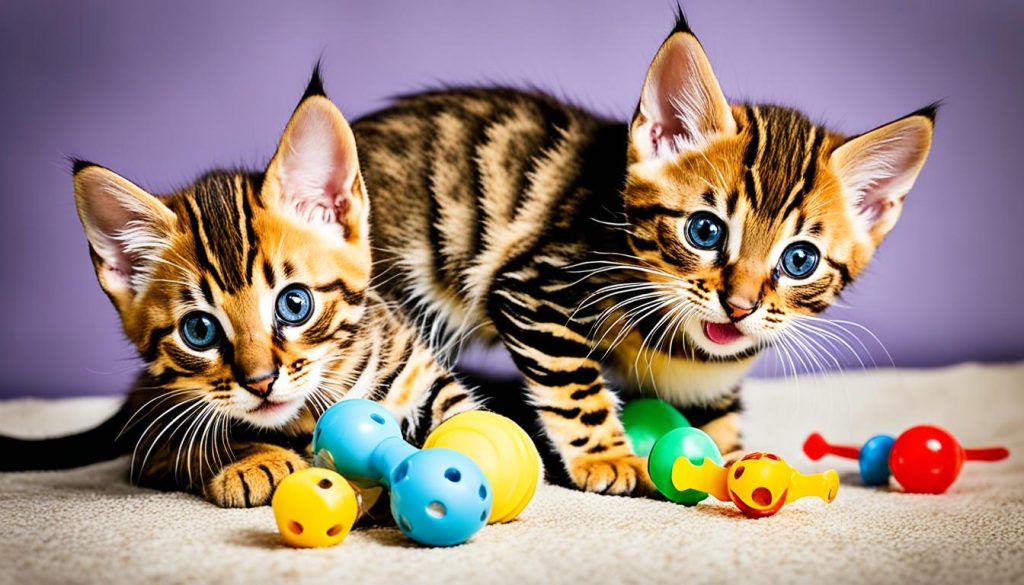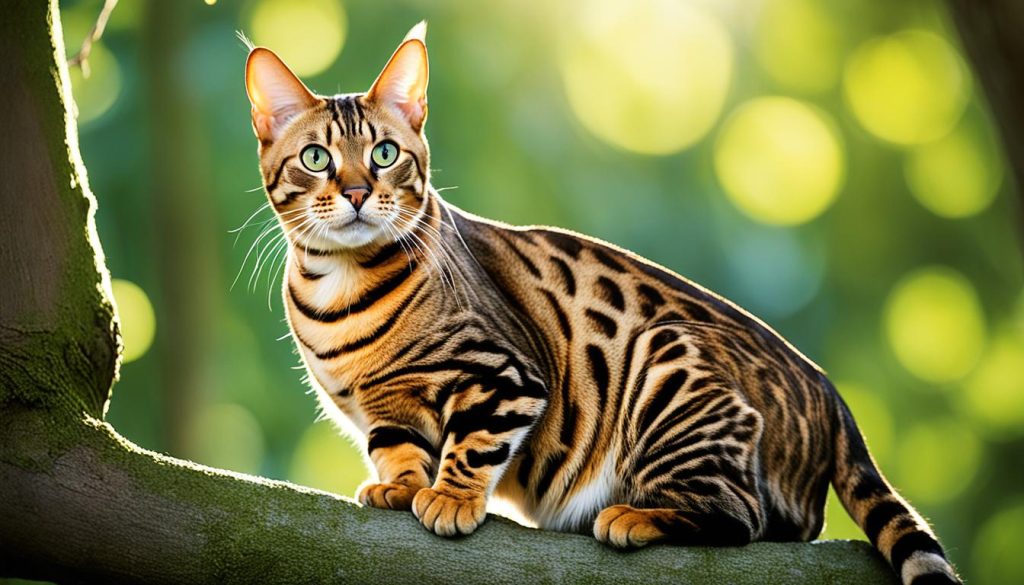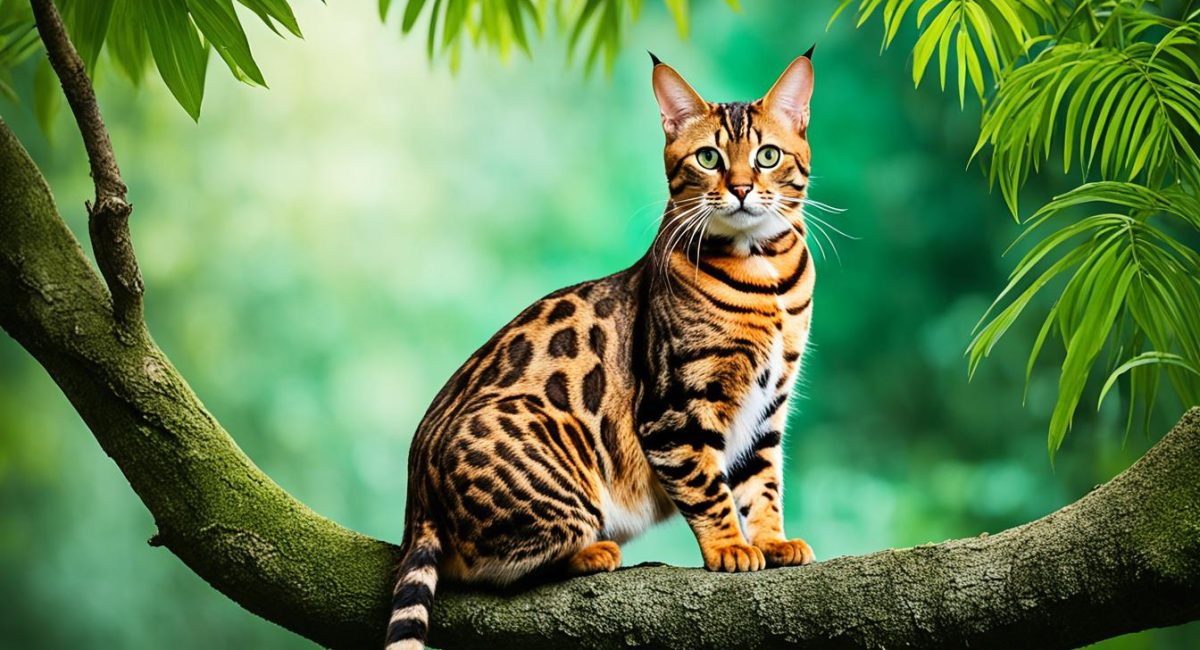Bengal Cats: Majestic Felines with Wild Charm
Did you know Bengal cats can get up to a 6% discount on Petduka.com1? These cats look a lot like Bengal tigers and come from the Asian leopard cat. They have become very popular2. From the Sundarbans mangrove forests to homes around the world, Bengal cats have found a special place. They mix their wild nature with being great pets.
This article will take you into the world of Bengal cats. We’ll look at their history, how they look, their playful nature, and how to care for them. If you’re thinking of getting a Bengal cat or just want to learn more, this guide will give you everything you need to know about these amazing cats.
Key Takeaways
- Bengal cats have a unique connection to their wild ancestors, the Asian leopard cat.
- Bengal cats are known for their striking coat patterns, ranging from spotted to marbled, and a diverse array of colours.
- These high-energy felines require ample playtime, mental stimulation, and a nurturing environment to thrive.
- Bengal cats may be predisposed to certain genetic conditions, necessitating regular veterinary check-ups and preventative care.
- Responsible breeding practices and early socialisation are crucial for the well-being and behaviour of Bengal kittens.
Tracing the Wild Ancestry of Bengal Cats
Jean Mill, an American breeder, started a project in the 1960s. She wanted to mix the Asian leopard cat with domestic cats. Her goal was to create a pet that looked exotic but was gentle34.
Thanks to Jean Mill’s work, the Bengal cat became a recognized breed in 19863. Today, there are hundreds of thousands of Bengal cats, made by over 2,000 breeders worldwide5.
From Asian Leopard Cats to Domestic Companions
The Bengal cat comes from the Prionailurus Bengalensis, or Asian Leopard Cat4. These wild cats have the unique rosette and spotted patterns seen in Bengals34.
Breeders have made the Bengal’s coat even more striking, offering a range of colours and patterns3. Bengals are now several generations away from the wild, making them friendly and tame like a typical tabby4.
Jean Mill’s Quest to Create a Hybrid Breed
Jean Mill, known as the “Godmother of Bengals,” started mixing Asian Leopard Cats with domestic tabbies in the 1970s4. Her work led to the creation of the Bengal cat we know today3.
Bengals are now popular pets, known for their unique looks and fun personalities. They’ve appeared in ads, movies, and online, making them a favourite in popular culture3.
The Striking Appearance of Bengal Cats
Bengal cats are known for their stunning looks, with a coat that reminds us of their wild ancestors. They have short, dense, and very soft fur. Their fur comes in many colours and patterns6.
Coat Patterns: Spots and Marbles
There are two main coat patterns: spotted and marbled. Spotted Bengals have rosette-like spots, which can be big or small7. Marbled Bengals have a design that looks like ancient paintings7.
Bengal cats have fur in colours from rich brown to snow white, and some even shine like glitter7. Brown Bengals are common, but snow and silver ones are rare and sought after7.
Muscular Build and Wild Allure
Bengal cats are also known for their strong muscles and amazing agility. They can jump and climb easily because of their sturdy build6. They move with a confident stride, showing off their elegance and power6.
The Bengal cat’s look, with its spots or marbled fur, shows off their wild roots and the hard work of breeders67.
Bengal: A Playful and Intelligent Companion
Bengal cats look wild but are really friendly and loving8. They bond strongly with their families, showing lots of energy and curiosity. These cats love solving problems and finding new adventures, making them perfect for those who like fun and brain challenges8.
They are often called “mini-leopards” because of their unique look and wild charm8. Bengal cats come from mixing Asian leopard cats with domestic shorthairs8. This mix creates a coat with special spots, rosettes, or marbling patterns8. They get along well with dogs and people, making them great for many homes8.
Bengals are very active and love water, showing a unique love for swimming8. They need lots of play and mental challenges to stay happy8. These cats talk to us in many ways, like chattering, meowing, purring, and chirping8.
Keeping their coat looking great requires regular grooming, like brushing every week to cut down on shedding8. These cats are smart and can learn tricks and play fetch, showing off their smarts8.
They keep their wild instincts and love being close to people8. With the right care, they can be great friends for over ten years9. It’s key to breed Bengals responsibly to ensure they are healthy and well-behaved8.
Many famous people, like Kristen Stewart and Paris Hilton, love Bengal cats for their special nature and looks8.
But, it’s important to know that in places like Australia, Bengal cats can’t be kept due to worries about mixing with feral cats8.
Caring for Your Bengal Cat
Owning a Bengal cat means giving them special care and attention. These cats are lively and curious, so making their environment interesting is key10.
Providing an Enriching Environment
Bengal cats love to play and explore. To keep them happy and healthy, they need lots of play and climbing spots. Toys, scratching posts, and climbing structures are great for their fun and natural instincts10.
It’s important to keep Bengal cats active to stop them from getting too fat. Playing with them using wand toys, puzzle feeders, and clicker training is fun. It also helps them bond with you10.
Grooming and Dietary Needs
Regular grooming is a must for Bengal cats. Their fur sheds a bit and brushing it often stops hairballs. They might need a bath now and then to stay clean10.
Bengal cats need a special diet that’s full of animal proteins and fats, but not too many carbs. Wet food is good for them because it’s more moist, which is good for their health11.
By giving your Bengal cat a fun environment, grooming them right, and feeding them well, they’ll be happy and healthy1011.
Health Considerations for Bengal Cats
Bengal cats are usually healthy but can face certain genetic issues. Owners need to know about these to keep their pets well. Regular vet visits and care are key to their long life.
Potential Genetic Conditions
Bengal cats might get hypertrophic cardiomyopathy (HCM), a heart disease12. They could also have hereditary blindness, or progressive retinal atrophy (PRA)12. Patellar luxation, a knee problem, is another issue they might face1213.
They might also get lymphoma, a cancer more common in Bengals12. Gastrointestinal problems can happen too, due to their curious nature12. Breeders should test for these conditions to lower the risk of passing them on.
Regular Veterinary Check-ups
It’s vital to keep up with vet visits for Bengal cats. These visits help spot and manage problems early, ensuring a long, healthy life13. Vaccines, parasite treatments, and quick action on illnesses or injuries are key to their health.
Knowing about Bengal cat health issues and managing their care well helps them thrive. Regular vet visits, a healthy lifestyle, and preventative care keep these amazing cats healthy13.
| Health Condition | Prevalence | Recommended Actions |
|---|---|---|
| Hypertrophic Cardiomyopathy (HCM) | Most common heart disease in Bengal cats | Responsible breeding, regular check-ups, and early intervention |
| Progressive Retinal Atrophy (PRA) | Can lead to blindness, symptoms include night blindness | Genetic testing, early detection, and supportive care |
| Patellar Luxation | Can cause lameness and difficulty walking | Corrective surgery, anti-inflammatory treatments, and physical therapy |
| Lymphoma | More prevalent in Bengal cats than other breeds | Regular check-ups, early detection, and appropriate treatment |
| Gastrointestinal Upsets | May occur due to Bengal cats’ curious nature | Proper diet, environmental enrichment, and prompt veterinary care |
“Regular veterinary check-ups, vaccinations, and a healthy lifestyle can help ensure your Bengal cat’s long and happy life.”
Breeding and Raising Bengal Kittens
Bengal cats are known for their striking looks and charming personalities. They are a favourite among cat lovers. However, it’s vital to breed them responsibly to ensure their health and happiness14. Breeders say too much owner involvement can lead to failed litters14. Letting nature take its course during birth is key14.
Good care during pregnancy and birth helps ensure successful births14. Cats can also absorb their unborn kittens if there are problems14.
Responsible Breeding Practices
Responsible Bengal cat breeding means testing for genetic issues before mating to stop passing on health problems15. Bengals can have health issues like PRA-b, PK-def, and HCM. These need regular checks and tests15. Testing for HCM costs a lot and requires a specialist, showing the cost of breeding Bengals15.
Importance of Socialisation and Early Care
New Bengal kittens need careful attention for proper growth and social skills. This helps them fit well into homes14. Some breeders have seen F1 Bengal mothers care for their kittens well14. But, too much human interference can be a problem14.
Keeping the mother cat in a quiet, dark place helps with successful birth14. Talking to a vet about birthing help is a good idea14. Good nutrition, including supplements and calcium, is key for Bengal kittens14.
Socialising and early care are key for Bengal kittens16. Cats are more likely to accept a new kitten than an older cat16. Introducing cats of the opposite sex is easier if they’re neutered16. It can take a few hours to a few days for a new kitten to settle16.
Preparation for introductions can include swapping bedding and toys to help cats get used to each other’s scent16. Watching over face-to-face meetings is important to manage any hissing or growling16. Most cats can live together if they’re not threatened and their basic needs are met16. The process of introducing cats can take a day or weeks, with a slow approach recommended16. Giving cats treats during and after meetings can help them associate the new cat positively16.

By breeding responsibly and giving careful attention during socialisation and early development, Bengal cat owners can ensure these beautiful cats thrive and fit well into their homes141516.
Training Your Bengal Cat
Bengals are known for being mischievous but are also smart and can be trained like dogs17. Training them has many benefits, like keeping them out of trouble and helping them stay healthy17. It’s important to keep training sessions short because they have short attention spans and lots of energy17. Punishing them can cause bad reactions like hiding and not eating, leading to more shedding and allergies17.
Positive Reinforcement Techniques
Training Bengals includes teaching them to use the litter box and stop bad habits like scratching and aggression17. Teaching them tricks like sitting and shaking hands keeps them mentally sharp and strengthens the bond with their owners17. It’s best to start training Bengal kittens early to set good habits for life17. Older Bengals might have hearing or sight loss and other health issues that make training harder17.
Keeping Up with Modern Training Methods
Tools like treats and clickers help train Bengal cats by rewarding good behaviour17. Feeding them low-quality snacks can cause weight gain and health problems17. A good diet for Bengals includes high-quality protein sources like salmon and chicken17.
Training a Bengal cat might mean playing with them for hours to wear them out18. Clicker training worked well for a Bengal cat from a young age18. Finding the right harness was key to training them to walk on a leash18. Training led to taking them on outdoor adventures, like hiking in national parks18.
Starting an Instagram account for a Bengal cat after a trip made it more popular and famous18. Sailing with other cats helped them socialise and enjoy new places18. Training can create a strong bond with the cat, opening up new skills and adventures18.
Is a Bengal Cat Right for You?
Thinking about getting a Bengal cat? It’s key to check if this breed fits your lifestyle and home19. Bengal cats are full of energy, smart, and love to play. They need a lot of attention and commitment from their owners2019.
Having an active lifestyle is a must for Bengal cat owners. These cats need lots of play and activities to keep them happy and healthy19. If you’re not active or can’t spend a lot of time with your Bengal, it might not be the right choice19.
Also, think about your home environment. Bengals are curious and love to explore. They might play with things they shouldn’t or mark their territory if they’re not happy19. You need to make sure your home is safe and interesting for them19.
Lastly, remember how much work a Bengal cat is21. They’re a special breed that costs more to care for. You’ll need to pay for vet visits, health checks, and training if needed21. Taking in a Bengal cat is a big commitment for the long run19.
So, think about your lifestyle, your home, and how much you can commit before getting a Bengal cat201921. By doing this, you can make sure you give your Bengal the best life and they’ll be a great friend19.

| Factors to Consider | Suitability for Bengal Cats |
|---|---|
| Active Lifestyle | Highly Suitable |
| Household Environment | Requires Careful Consideration |
| Commitment Level | Significant Commitment Required |
Conclusion
Bengal cats mix wild beauty with home comfort. They stand out with their looks, speed, and loving nature. This makes them a top choice for many cat lovers.
They make up about 10% of exotic cats and their popularity has grown by 15% in five years22.
Bengal cats need a lively and interesting home to be happy. They live between 12-16 years, so they’re a big commitment. But, they also have a 20% chance of acting like their wild relatives22.
Before getting a Bengal cat, make sure you can give them the active life they need. With the right care, a Bengal cat will be a loyal domestic companion. They’re 30% pricier than other cats because of their unique look and background22.
FAQ
What is the origin of the Bengal cat breed?
In the 1960s, a California breeder named Jean Mill started mixing Asian leopard cats with domestic cats. She wanted to create a breed that looked like a wild leopard but was gentle like a house cat.
What are the distinctive features of Bengal cats?
Bengal cats stand out with their beautiful coat patterns, similar to leopards or jaguars. Their fur is soft and dense. They come in spotted or marbled patterns. They also have a strong build and move with grace and confidence.
What is the temperament of Bengal cats?
Despite their wild look, Bengal cats are very loving and friendly. They love to be close to their owners and are full of energy. They are smart, curious, and always up for an adventure.
What are the care requirements for a Bengal cat?
Bengal cats need a lively environment to keep their minds and bodies busy. They need lots of playtime, toys, and places to climb and scratch. They should get regular exercise and eat a balanced diet. Keeping their coat clean is also important.
What are some common health concerns for Bengal cats?
Bengal cats are usually healthy but can face issues like heart disease, blindness, and kneecap problems. Regular vet visits, shots, and a healthy lifestyle can help them live a long, happy life.
What should I consider when breeding or raising Bengal kittens?
Breeding Bengal cats responsibly is key to their health and well-being. It’s important to check for genetic problems before breeding to avoid them. Breeders should focus on health and genetic diversity. Bengal kittens need special care to grow and get along with others.
How do I train a Bengal cat effectively?
Training Bengal cats takes patience and consistency. Using positive reinforcement works well, rewarding good behaviour and not punishing bad. Playing with them is a great way to train, as they love to move. Clicker training can also be very effective.
Is a Bengal cat the right pet for me?
Bengal cats are very active and need a lot of attention. They love to play and need a lively home. If you’re looking for a pet that will keep you active, a Bengal cat might be perfect. But, you must be ready to give them lots of playtime and care.
Source Links
- Bengal – https://www.petduka.com/en/knowledge-base/cat-breeds/bengal/
- Bengal Cats: A Graceful Blend of Wild and Domestic – https://petsoften.com/bengal-cats-a-graceful-blend-of-wild-and-domestic/
- A Historical Journey into Bengal Cat Origins and Ancestry – Tracing th – https://pawtopiabengal.ca/blogs/news/bengal-cat-history
- Are Bengal Cats Really Wild? – https://www.divinuspridebengals.com/post/are-bengal-cats-really-wild
- DNA Study Demystifies Bengal Cat Ancestry – https://www.technologynetworks.com/genomics/news/dna-study-demystifies-bengal-cat-ancestry-385109
- Bengal Cat Guide to the Breed, Buying Tips, Facts and Photos – https://www.bengalcat.co.uk/
- The Bengal Cats Different Types and Colours – https://www.bengalcat.co.uk/types-of-bengal-cats/
- 15 Facts About Bengal Cats | FELIWAY – https://www.feliway.co.uk/blogs/news/15-fascinating-facts-about-bengal-cats
- Bengal Cats Pros and Cons | Spot® – https://spotpet.com/blog/breed-tips/are-bengal-cats-good-pets
- Bengal Cats: The Beautiful Wild Cat Hybrid – https://www.thesprucepets.com/bengal-cats-1238154
- The ins and outs of Bengal cat care – https://untamed.com/blogs/cat-breeds/bengal-cat-care
- Bengal – https://www.petmd.com/cat/breeds/bengal
- Bengal – https://www.pdsa.org.uk/pet-help-and-advice/looking-after-your-pet/kittens-cats/bengal
- Quality Bengal Kittens – Breeding Early Generation Cats – https://quality-bengal-kittens.com/breeding-early-generation-cats
- So You Want to Breed Bengals: The Confessions of a Bengal Breeder – https://www.elysianbengals.com/post/2019/04/25/so-you-want-to-breed-bengals-the-confessions-of-a-bengal-breeder
- Introducing a new cat or kitten | Bengal Cat World – https://bengalcatworld.com/advice-centre/introducing-a-new-catkitten-to-an-existing-one/
- How to train a Bengal cat—a crash course – https://untamed.com/blogs/cat-breeds/how-to-train-a-bengal-cat
- How I Trained my Bengal Cat: Mia’s Epic First 3 Years of Life – https://www.outdoorbengal.com/en-au/blogs/bengal-cats/how-i-trained-my-bengal-cat
- Do you have the Right Mindset for a Bengal cat? – https://quality-bengal-kittens.com/bengal-cat-blog/blog/do-you-have-the-right-mindset-for-a-bengal-cat
- IS A BENGAL CAT RIGHT FOR YOU? – https://registeredbengals.com/blog/is-a-bengal-cat-right-for-you
- Buying a Bengal cat, is this Beautiful Breed right for you? – https://www.bengalcat.co.uk/buying-a-bengal-cat/
- Conclusion | Hungry Bengal: War, Famine and the End of Empire – https://academic.oup.com/book/2861/chapter/143461280

